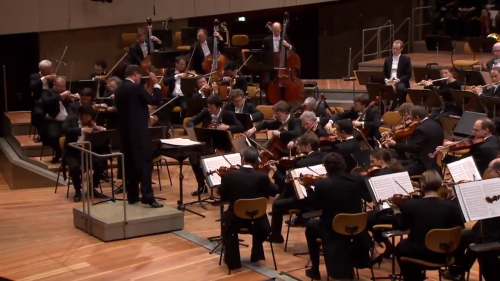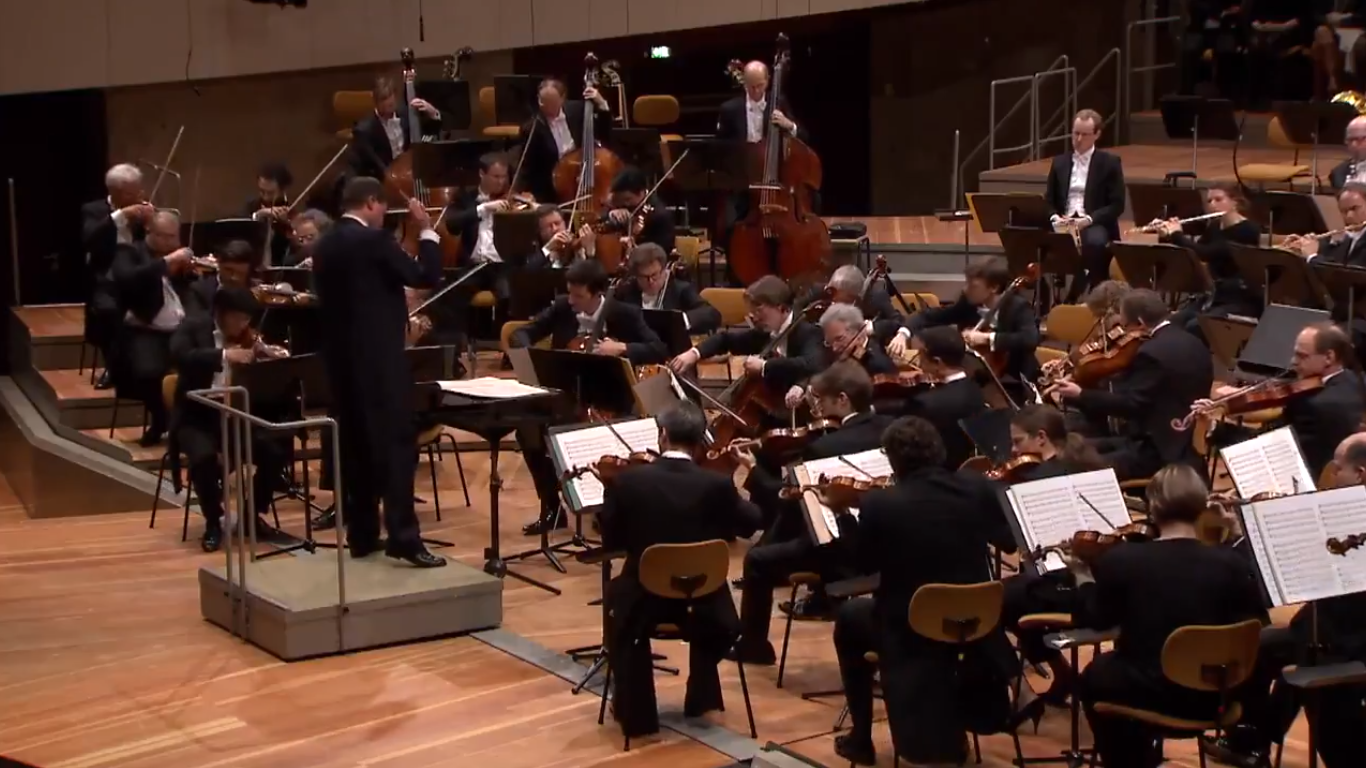
 Germany ‘The Golden Twenties’ – Hindemith, Busoni, Richard Strauss: Camilla Nylund (soprano), Berlin Philharmonic / Christian Thielemann (conductor). Performed at the Philharmonie Hall and streamed on the Digital Concert Hall (click here), 27.2.2021. (GT)
Germany ‘The Golden Twenties’ – Hindemith, Busoni, Richard Strauss: Camilla Nylund (soprano), Berlin Philharmonic / Christian Thielemann (conductor). Performed at the Philharmonie Hall and streamed on the Digital Concert Hall (click here), 27.2.2021. (GT)

Hindemith – Neues vom Tage (News of the Day), Overture from the Opera and the Concert ending
Busoni – Tanz-Walzer for orchestra, Op.53
Johann Strauss II – Künstlerleben, Waltz, Op.113
R. Strauss – Ständchen, Op.17, No.2, Freundliche Vision, Op.48, No.1, Wiegenleid, Op.41 No.1, Allerseelen, Op.10 No.8, Zueigung, Op.10 No.1, Morgen, Op.27, No.4, (versions for voice and orchestra); Die Tageszeiten, song cycle for male voice choir and orchestra, Op.76.
This was the fifth, and final, event in the ‘The Golden Twenties’ online festival and its highlights were a mix of vocal works and short orchestral pieces by celebrated composers of the period. In his introduction, the Berlin Philharmonic’s First Concertmaster Noah Bendix-Balgley explained ‘the Berlin of the twenties became the centre of musical modernity, and that the composers of the period were all very different in embracing the “New Objectivity”; rejecting beauty in art and favouring ideas in the post-war arts.’ Certainly, the composers presented in this final programme were represented by Hindemith ‘the revolutionary, Busoni the experimenter in new musical worlds, while Richard Strauss was the “superstar” of German music – the creator of orchestral poems and neo-classical operas.’
Following upon his Hin und Zurück collaboration with Marcellus Schiffer, Hindemith’s next comic opera parodied Puccini and Berlin cabaret, and portrayed the banality of life in Germany with its bureaucracy, the cheap sensationalism of the press and the emptiness in social discourse. The premiere at the Kroll Theatre under the baton of Otto Klemperer in 1929 shocked its audience not only for the nudity of the principal singer, but the modernism of its orchestration. Hitler denounced Hindemith’s ‘degenerate music’ ensuring his banning during the Third Reich. This performance of the overture and concert ending allowed us to grasp the essence of the composer’s controversial stage work. The overture opened brightly on the strings, and the startlingly luminous piccolo flute of Jelka Weber, while the clarinets adopted a brisk tempo, joined by the oboes invoking the chatter of newspaper boys shouting on the streets of Berlin. The flute of Emmanuel Pahud was particularly eloquent, and the clarinet cadences were gorgeous, becoming ever more eventful, while the tête-à-tête between different wind instruments continued with the bassoon of Daniele Damiano. Along with the saxophone, this recreated the voices of Berlin folk on the streets and the echo of jazz from cafes and bars. The tempo then switched with flutes and trombones loudly screeching all before the music suddenly ended.
Busoni’s Tanz-Walzer picks up from Ravel’s La Valse of a few years before, creating a parody of a waltz as if seen and heard from afar. The trombones roared during the opening, and for a second this was almost like the opening bars of Also Sprach Zarathustra, yet there emerged intriguing ideas from the clarinet, bassoon, and flute in a graceful, restful and enigmatic idiom. A peculiar anecdotal idea arrived on the oboe and it was interesting to see how engaged conductor Christian Thielemann was in this music, adopting almost comic facial expressions. The themes emerge and suddenly disappear, and according to Thielemann in his interview during the interval, this piece was a picture of Berlin during the civil conflict of 1919-1920 and gives a sense of the period. There were very tuneful harmonies, with wonderful phrasing and rubato on the woodwind. It is amazing that this piece is not heard more often, and finally, the piece closed in a grand culmination that was bright and effervescent. Busoni himself conducted the premiere in 1921 and Wilhelm Furtwängler conducted Tanz-Walzer with the Berlin Philharmonic in 1930, and he conducted it as many as six or seven times in the next few seasons. Busoni greatly admired Johann Strauss II and dedicated his Tanz-Walzer to the Viennese composer.
Johann Strauss II’s Künstlerleben was delightfully performed with fine playing from the horn of Stefan Dohr and the oboe of Albrecht Mayer, supported by great playing from the clarinets. Strangely, it didn’t seem out of character with the preceding pieces as the same degree of underlying sadness and poignancy of the Viennese waltz seemed to occupy the similar world of twenties Berlin.
The Swedish soprano Camilla Nylund was a more than suitable replacement in this selection of late romantic lieder by Richard Strauss after Diana Damrau cancelled. Nylund has recently performed with Thielemann in Le nozze di Figaro, and they enjoy a long collaboration in German operatic repertoire. In the opening Ständchen, following the beautiful flute intonation of Pahud, Nylund’s beautifully creamy soprano was splendidly radiant; while in the following Freundliche Vision, the mood of love, expectation and beauty was portrayed passionately by the singer. The collaboration between the conductor and the soprano was sublimely observed in Wiegenleid and the enchanting beauty of her singing evoked heavenly love beset by shimmering blossoms. In Allerseelen, Nylund sang of flowers gracing the grave of a loved one, while Zueigung, was brief yet resplendent, and in the final Morgen, the violin solo of Daniel Stabrawa accompanied by the harp featured in this poignant song of the morning bringing beauty to the world.
Based on Joseph Eichendorff’s ‘Wanderlieder’, Richard Strauss’s Tageszeiten was first performed in 1929 in Vienna, and this performance was only its second by the Berlin Philharmonic since that given by Furtwängler in 1930. Der Morgen was launched by the choir located above the orchestra, accompanied by the wind and orchestra in a great swelling Straussian harmony. The next movement, Mittagsruh opened with a rather tentative idea on strings joined by the choir – here the influence of German folk song is palpable and colourful in its rich melodiousness. Der Abend opened vivaciously on a roll of the timpani and the choir’s singing was nicely supported by the high woodwind, with the singing about the earth rustling (‘Rauscht die Erde wie in Träumen, wunderbar mit allen Bäumen’) resounding on the timpani before dying away. A horn solo from Stefan Dohr opened Die Nacht, and the rich tone merged with the choir singing about springs and the sweet night covered with cool shadows (‘Die Quellen klagend gehn. Denn müd ging auf den Matten die Schönheit nun zur Ruh, Es deckt mit kühlen Schatten die Nacht das Liebchen zu’) The magnificent orchestration rich in melody rose to a storm of rich harmony with horns and tremolos on the strings reprising the opening hymn of the Der Morgen to bring this fine and still much-neglected work to a peaceful close.
Gregor Tassie
